Today’s post, dear readers, come to you from Kansas City, Missouri, where I am kicking around this week for a conference.
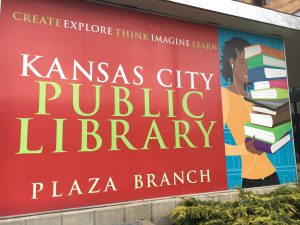
And before anyone makes a joke about corn or hayseeds, hold off. I can almost guarantee you, I’ve heard them all (some of them from the good people of Kansas City!)
But, to be honest, it’s a really lovely city, that is gradually, but very clearly recovering from the economic collapse of 2008, with small businesses, breweries, and restaurants taking up residence in vacated movie theaters and industrial sites, and theaters up and down Main Street. Closer to the river, there is plenty of diverse and fascinating architecture, and, across the city, from everything I’ve seen, a genuine community spirit. One of the first indications of this I found was in my walk to the nearest Library:
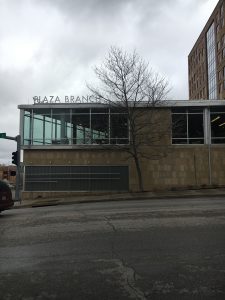
One of the first things that strikes visitors from the Northeast to the midwest is how much space there is. That may not be true in all places, but here, it is. One of the academic libraries at this conference has enough open floor space that I was tempted to perform an impromptu gymnastics routine, just because I could without bumping into anything. The Kansas City Public Library Plaza Branch is a city block in size, with big, wide windows, and a whole bunch of comfy chairs positioned by them. A quick browse of their website shows that they have spaces designated specifically for community events and book groups, as well as film screenings, exhibit space…and a coloring space. I fell in love as soon as I saw that.
For all the fun that is poked at the midwest, this is very clearly a library system that is devoted to their patrons from the very start. This branch in particular prides themselves on their children’s room and the wide array of programs they put on for babies, toddlers, and school-aged patrons.
But I haven’t got to the best part yet. For anyone who has ever despaired of the parking situation in downtown Peabody, get a look at this:
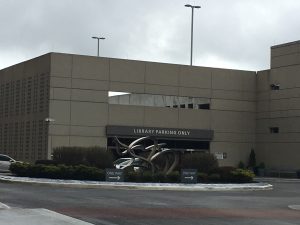
The Library. It has it’s own parking garage. For patrons only.
For those of you who might want to explore Kansas City a bit more from the comfort of their own reading nook, here are a few books set in and around the city that will give you some different perspectives on the area and what it means to live here:
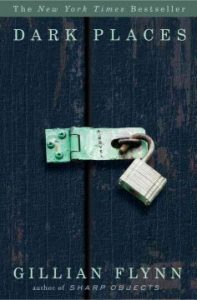 Dark Places: Gillian Flynn’s complex murder mystery was one of my favorite reads of last year, and provides a haunting view of Kansas City and its surroundings, reflected through the eyes of Libby Day, Libby was seven when her mother and sisters were murdered while she hid nearby, and her testimony helped send her brother to prison for the crime. Twenty-five years later she’s still struggling to get through each day, but when she starts to sell off family artifacts to make some money–the buyers, a group of obsessed true crime fanatics, also push her to look into the murders, which eventually forces her to question her memories. Libby herself is like an abandoned building–stuck in the past and pretty unappealing at first glance, but as this story goes on, and she finds herself with a purpose, Libby turns out to be a fascinating and surprisingly sympathetic character. Her trip throughout Kansas City and its surroundings is a tour of its abandoned and forgotten places, giving this book a pretty bleak outlook, but one that is so clearly drawn you’ll want to wash the dust off your hands when you’re done.
Dark Places: Gillian Flynn’s complex murder mystery was one of my favorite reads of last year, and provides a haunting view of Kansas City and its surroundings, reflected through the eyes of Libby Day, Libby was seven when her mother and sisters were murdered while she hid nearby, and her testimony helped send her brother to prison for the crime. Twenty-five years later she’s still struggling to get through each day, but when she starts to sell off family artifacts to make some money–the buyers, a group of obsessed true crime fanatics, also push her to look into the murders, which eventually forces her to question her memories. Libby herself is like an abandoned building–stuck in the past and pretty unappealing at first glance, but as this story goes on, and she finds herself with a purpose, Libby turns out to be a fascinating and surprisingly sympathetic character. Her trip throughout Kansas City and its surroundings is a tour of its abandoned and forgotten places, giving this book a pretty bleak outlook, but one that is so clearly drawn you’ll want to wash the dust off your hands when you’re done.
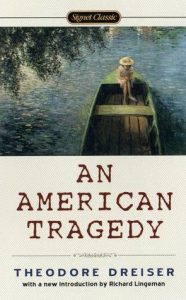 An American Tragedy: On one level, Theodore Dreiser’s classic novel is the story of the corruption and destruction of one man, Clyde Griffiths, who forfeits his life in desperate pursuit of success. On a deeper, more profound level, the novel represents a massive portrayal of the society whose values both shape Clyde’s tawdry ambitions and seal his fate: It is an unsurpassed depiction of the harsh realities of American life and of the dark side of the American Dream. Based on a true murder case that fascinated Dreiser, this novel doesn’t move quickly, and there isn’t a great deal of action, but it’s a wonderfully complex novel that can be read in a number of ways. Our Classics Book Group read this book some time ago, and I don’t remember a book that prompted so much debate. The Kansas City here is an historic one, when the midwest was seen by many as the last bastion of ‘civilization’, as so much of the West was still being ‘settled’ and industrialized. It is the model of the ‘American Dream’, and thus a place where anything is possible…but not for everyone.
An American Tragedy: On one level, Theodore Dreiser’s classic novel is the story of the corruption and destruction of one man, Clyde Griffiths, who forfeits his life in desperate pursuit of success. On a deeper, more profound level, the novel represents a massive portrayal of the society whose values both shape Clyde’s tawdry ambitions and seal his fate: It is an unsurpassed depiction of the harsh realities of American life and of the dark side of the American Dream. Based on a true murder case that fascinated Dreiser, this novel doesn’t move quickly, and there isn’t a great deal of action, but it’s a wonderfully complex novel that can be read in a number of ways. Our Classics Book Group read this book some time ago, and I don’t remember a book that prompted so much debate. The Kansas City here is an historic one, when the midwest was seen by many as the last bastion of ‘civilization’, as so much of the West was still being ‘settled’ and industrialized. It is the model of the ‘American Dream’, and thus a place where anything is possible…but not for everyone.
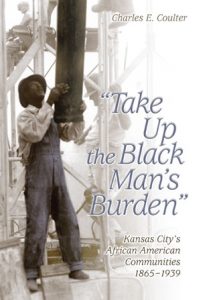 Take Up the Black Man’s Burden: Unlike many cities farther north, Kansas City, Missouri—along with its sister city in Kansas—had a significant African American population by the mid-nineteenth century and also served as a way station for those migrating north or west. “Take Up the Black Man’s Burden” focuses on the people and institutions that shaped the city’s black communities from the end of the Civil War until the outbreak of World War II, blending rich historical research with first-person accounts that allow participants in this historical drama to tell their own stories of struggle and accomplishment. Impressively, this isn’t just a book of famous biographies, though it does feature famous citizens such as activists Ida M. Becks and Josephine Silone Yates, and state legislator L. Amasa Knox, but it also focuses on ordinary laborers, domestics in white homes, and railroad porters. It tells how various elements of the population worked together to build schools, churches, social clubs, hospitals, the Paseo YMCA/YWCA, and other institutions that made African American life richer. It also documents the place of jazz and baseball, for which the community was so well known, as well as movie houses, amusement parks, and other forms of leisure. This is a book about race, but also about a city, and is a rich and unique way to look at the history of the midwest and the United States.
Take Up the Black Man’s Burden: Unlike many cities farther north, Kansas City, Missouri—along with its sister city in Kansas—had a significant African American population by the mid-nineteenth century and also served as a way station for those migrating north or west. “Take Up the Black Man’s Burden” focuses on the people and institutions that shaped the city’s black communities from the end of the Civil War until the outbreak of World War II, blending rich historical research with first-person accounts that allow participants in this historical drama to tell their own stories of struggle and accomplishment. Impressively, this isn’t just a book of famous biographies, though it does feature famous citizens such as activists Ida M. Becks and Josephine Silone Yates, and state legislator L. Amasa Knox, but it also focuses on ordinary laborers, domestics in white homes, and railroad porters. It tells how various elements of the population worked together to build schools, churches, social clubs, hospitals, the Paseo YMCA/YWCA, and other institutions that made African American life richer. It also documents the place of jazz and baseball, for which the community was so well known, as well as movie houses, amusement parks, and other forms of leisure. This is a book about race, but also about a city, and is a rich and unique way to look at the history of the midwest and the United States.
Safe travels, dear readers!
